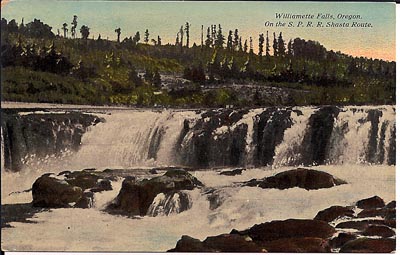Corvallis man's cattle-powered riverboat didn't work out
Name of inventor who tried the treadmill-powered vessel lost in the mists of time, but he may be father of town's passion for alternative transportation
EDITOR'S NOTE: A revised, updated and expanded version of this story was published in 2017 and is recommended in preference to this older one. To read it, click here.

This image of Willamette Falls before the build-up of paper mills on
either side comes from a postcard dating from circa 1920. It's these
falls that the "Hay Burner" was allowed to go over. For a larger version
of this image, click here.
By Finn J.D. John — July 30, 2009
Corvallis today has a bit of a reputation as one of the state’s leaders in alternative-power transportation. Of course, as is the case in east Eugene and in Portland’s more progressive neighborhoods, every other car that drives by on the streets is a Prius.
But it’s more than just that. Each year at da Vinci Days, a bunch of crazy people with super-powerful welders and nothing better to do enter a contest to drive a human-powered “kinetic sculpture” through various obstacles, and tiny electric cars scream through the streets in a race. An Oregon State University engineering department team participates, each year, in the solar-car race across the North American continent.
But most people don’t know how far back into the past that propensity goes. Corvallis is, after all, an engineering town, more so than any other Oregon city that I know of. Engineers are always thinking about things like this.
That’s as true today as it was 150 years ago, just before the Civil War, when a Corvallis inventor had cooked up an idea for a riverboat that could go where no boat had gone before.
This boat was a paddlewheel outfit — a small sidewheel flatboat. But it needed no coal and no wood to fire its boilers. All it needed was a team of oxen on a treadmill and a small mountain of hay. The cattle would lumber along as if walking down the middle of the river, turning the mechanism, which would in turn spin the sidewheels. It’s not magic, it’s science! The inventor christened his vessel the “Hay Burner.”
The Hay Burner left Corvallis for its maiden voyage to Oregon City one summer day in 1860. As it neared the then-thriving town of Wheatland, near present-day Salem, the boat hung up (or, rather, “walked ashore,” as Corning wisecracks in his book) on a gravel bar at McGoogin’s Slough. It was at this point that one major drawback to the “hay-burning” system became apparent: A regular coal-burning boat used no fuel when it wasn’t under way. On the other hand, with nothing to do but eat, the oxen ramped up their fuel consumption considerably while the crew worked to get the boat off the rocks, and by the time they were back under way — a passing steam-powered riverboat had pulled it free with a hawser — the “engines” had wolfed down most of the “fuel.”
What exactly happened to the “fuel” after the cattle had eaten it? On this point, the historical record is, perhaps mercifully, silent. One hopes somebody was fast enough with a shovel to keep the fresh “spent fuel” from revolving under the treadmill and gumming up the works. But then, knowing Corvallis engineers, there was probably some sort of provision made for that.
In any event, the “Hay Burner” finally made it to Oregon City, where the pilot stocked up on more hay. But when it was time to head back upstream, he made an awful discovery. The poor cows could not generate enough power to push the boat upstream against the current — no matter how much they ate.
And thus ended both the maritime career of the cattle — which were sold off in Oregon City — and the reputation of Corvallis as a hot spot for innovative naval architecture. The "Hay Burner" was allowed to go over the falls in Oregon City.
And, so far as the historical record goes, that's the end of the story. I have searched in vain for the name of the inventor of this vessel, with an eye to finding out more. Corning merely refers to him — sarcastically, one presumes — as a “genius.” If any of you folks reading this know who this fellow was, I would love to hear from you. Drop me a note at finn@offbeatoregon.com or 541-357-2222 and I’ll pass the information along in a future column.
(Sources: Sullivan, William. Hiking Oregon’s History. Eugene: Navillus, 2007; Corning, Howard M. Willamette Landings: Ghost Towns of the River. Portland: OHS, 1947/1973.)
-30-











